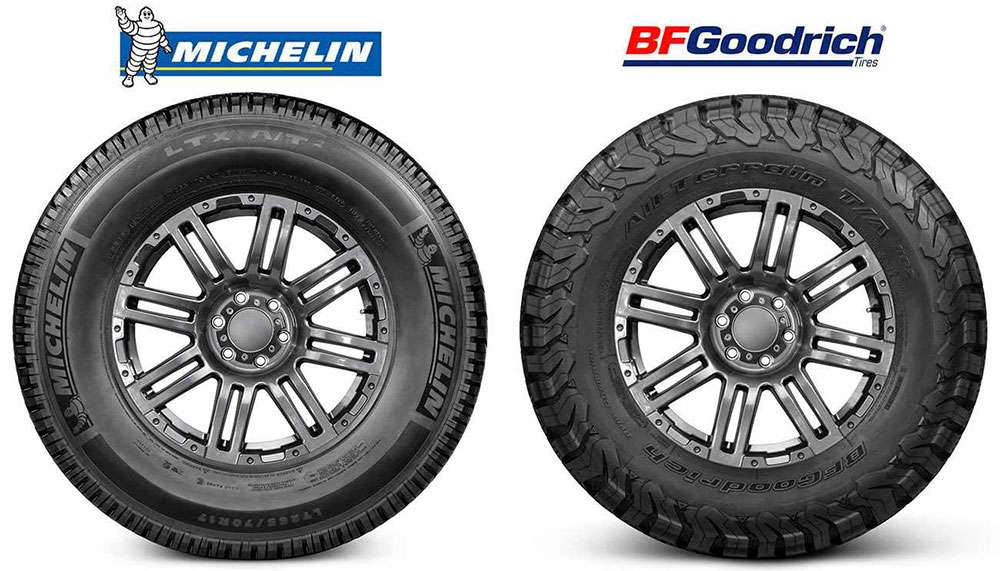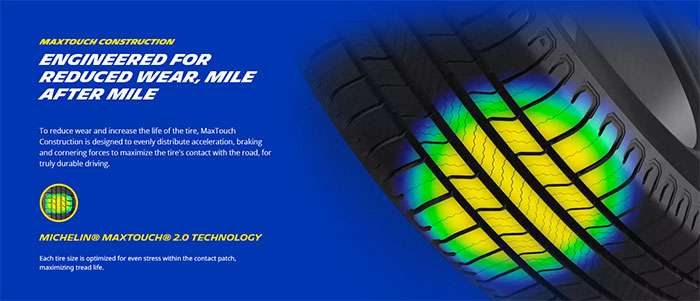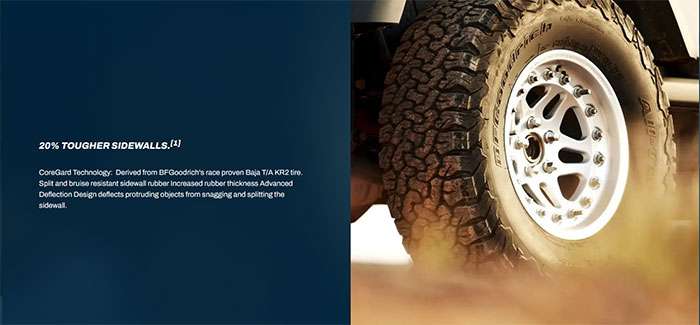
When it comes to selecting all-terrain tires, the Michelin LTX AT2 vs BFG KO2 comparison represents one of the most important decisions facing drivers today. The Michelin LTX AT2 delivers impressive durability with 35% longer life on gravel compared to leading competitors, making it an excellent choice for drivers who frequently navigate unpaved roads. Meanwhile, the BFGoodrich All-Terrain T/A KO2 boasts 20% tougher sidewalls than previous models, offering superior protection against harsh off-road conditions.
Both tires come from respected manufacturers, yet they serve distinctly different needs. Michelin, a global leader in tire innovation, stands behind their LTX AT2 with a substantial 60,000-mile limited warranty. BFGoodrich offers a 50,000-mile warranty for the KO2. The key difference lies in their design approach – the AT2 uses a more compact tread pattern with greater surface area for enhanced on-road performance, while the KO2 features wider, deeper grooves and broader shoulders specifically designed for superior off-road capability. For muddy, rocky, or challenging terrain, the KO2 holds a clear advantage, but this comes with trade-offs in everyday road comfort.
Understanding which all-terrain tire best fits your driving needs is essential before making this investment decision in 2025.
The construction differences between the Michelin LTX AT2 vs BFG KO2 reveal distinct engineering philosophies that directly impact performance across different terrains. These design choices determine how each tire behaves on pavement versus off-road conditions.
The Michelin LTX A/T2 uses a straighter tread pattern with narrower grooves that creates a larger contact patch with the road. This conventional all-terrain approach puts more rubber on the pavement, improving on-road grip and stability. The A/T2's grooves follow a slanted, singular direction that delivers predictable handling on paved surfaces.
The BFGoodrich KO2 takes a completely different approach with an aggressive, interlocking tread pattern featuring wider and deeper grooves. This jagged design immediately signals its off-road focus. The KO2's open tread configuration performs exceptionally well on loose surfaces like gravel and mud because it evacuates material more effectively. This interlocking pattern also promotes even wear distribution throughout the tire's lifespan.
Shoulder design reveals another key difference. The LTX A/T2 features narrower shoulders compared to the KO2 but includes effective biting edges that improve traction on challenging surfaces. These specialized edges prove particularly valuable in snowy conditions, providing grip where traditional tread patterns struggle.
The BFG KO2 features significantly wider shoulders that extend the aggressive tread pattern further around the tire. This design provides better lateral stability during off-camber driving situations common in serious off-roading. The broader shoulders also contribute to the KO2's rugged appearance and enhanced capability.
Both manufacturers address rock and debris protection through different methods. The BFG KO2 includes dedicated stone ejectors designed to remove gravel and stones that become lodged in the tread grooves. This feature prevents stones from drilling into the tire base, avoiding punctures or premature wear.
Protection extends beyond the tread to the sidewalls. The KO2 incorporates BFGoodrich's proprietary CoreGard Technology with bruise-resistant sidewall rubber engineered to resist protruding objects. Its Advanced Deflection Design actively prevents sticks and stones from snagging and splitting the sidewall.
The Michelin LTX A/T2 uses side biter lugs in the sidewall that serve dual purposes – providing protection against sidewall damage during off-road driving while enhancing snow traction. These design elements show how both manufacturers balance puncture protection with traction in challenging conditions.
Daily road performance separates good all-terrain tires from exceptional ones. The Michelin LTX AT2 vs BFG KO2 comparison reveals significant differences in how these tires handle everyday driving situations.
The Michelin LTX A/T2 excels in dry road conditions thanks to its straighter tread pattern and narrower grooves that maximize pavement contact. This expanded contact patch delivers responsive steering and excellent longitudinal traction. The tire provides quick, fluid steering response and impressive cornering grip even at higher speeds.
The BFGoodrich KO2 sacrifices some dry road contact due to its larger tread blocks and wider grooves. Despite this trade-off, the KO2 remains remarkably safe on paved surfaces, delivering good corner grip and excellent straight-line traction. The difference becomes most apparent during aggressive cornering where the LTX A/T2's superior contact area provides a clear advantage.
Wet performance reveals another key distinction between these competitors. The Michelin LTX A/T2 demonstrates excellent wet-weather capability with its design optimized for year-round use. The tread effectively channels water away from the contact patch, reducing hydroplaning risk.
The KO2 performs adequately on clean wet pavement but shows vulnerability to hydroplaning when encountering standing water at highway speeds. The tread pattern, while excellent for off-road traction, lacks the water evacuation capacity needed for large volumes of standing water. Drivers of heavier vehicles may experience reduced grip when hitting puddles at 55-65 mph.
Road noise presents perhaps the most noticeable everyday difference between these tires. The Michelin LTX A/T2 offers a significantly quieter ride thanks to its denser design that limits air movement through the tread. This creates a more peaceful cabin environment, especially during highway driving.
The BFG KO2, with its wider grooves and more aggressive pattern, generates increased road noise. Many users report that KO2s are quiet initially but become progressively noisier as they wear. Some drivers find them "remarkably quiet for an AT tire" compared to more aggressive alternatives.

Image Source: Michelin
Comfort represents another critical distinction. The Michelin LTX A/T2 delivers exceptional ride comfort through its MaxTouch Construction that optimizes road contact. This technology, combined with vibration-dampening design, creates smoother ride quality particularly valued by drivers who spend significant time on paved roads.
The BFGoodrich KO2, while less comfortable on highways, provides effective shock absorption off-road. Its E-rated construction offers a firmer ride than the LTX A/T2, making it less suitable for drivers prioritizing on-road comfort. Once properly balanced, the KO2 demonstrates "excellent on and off-road manners" that many owners appreciate.
The true test of all-terrain tires comes when pavement ends and challenging terrain begins. Off-road performance reveals the most significant differences between the Michelin LTX AT2 vs BFG KO2, with each tire showing distinct strengths across various surfaces.
The BFGoodrich All-Terrain T/A KO2 dominates muddy conditions with its wide grooves and interlocking tread pattern. This aggressive design excels in muddy terrain through superior self-cleaning properties that prevent mud buildup. The wider groove pattern channels mud away from the contact patch more effectively, maintaining grip when conditions get sloppy.
The Michelin LTX A/T2 faces clear limitations in muddy conditions. Its tread design works well on hard-packed surfaces but lacks the necessary void ratio to maintain traction when terrain turns muddy.
The KO2 carries the coveted 3-Peak Mountain Snowflake (3PMSF) rating, certifying its winter performance capabilities. Its 3D sipes provide multi-directional biting edges that enhance traction significantly on snow-covered surfaces.
The LTX A/T2 relies on its notched blocks (Michelin Biting Edges) for snow traction. Without the wider grooves and aggressive siping of the KO2, it delivers less confident winter performance overall.
Rocky paths demand serious sidewall protection. The KO2's CoreGard technology provides superior resistance against sharp rocks and reduces sidewall failure risk during technical off-road driving. This reinforced construction handles punishment that would damage lesser tires.
The LTX A/T2 performs adequately on rocky terrain but lacks the specialized sidewall protection of its competitor. This tire prioritizes on-road refinement over extreme off-road durability.
The KO2's serrated shoulder design paired with dedicated stone ejectors prevents gravel from lodging in the tread. This feature maintains traction while protecting the tire from internal damage caused by embedded stones.
The Michelin LTX A/T2 handles gravel roads competently and demonstrates impressive longevity on such surfaces. Its tread compound resists chipping and tearing effectively, making it suitable for regular gravel driving.
For serious off-road adventures, the BFG KO2 stands as the clear winner. The Michelin excels on hard-packed surfaces, offering a balanced approach that favors on-road performance over extreme off-road capability.
Durability represents the ultimate test of value when selecting all-terrain tires. The Michelin LTX AT2 vs BFG KO2 comparison reveals distinct approaches to longevity that directly impact your long-term investment.
Michelin stands behind the LTX AT2 with an impressive 60,000-mile limited warranty, demonstrating exceptional confidence in their product's longevity. This coverage stems from Michelin's MaxTouch Construction™ that effectively distributes stress across the tire's contact patch. BFGoodrich offers a substantial 50,000-mile warranty for the KO2, still impressive for an aggressive all-terrain tire but falling short of its competitor's coverage.
The warranty difference reflects each tire's intended use. The LTX AT2's longer coverage suits drivers prioritizing highway miles and occasional gravel roads, while the KO2's warranty accounts for more demanding off-road applications.

Image Source: BFGoodrich
The KO2 features BFGoodrich's proprietary CoreGard technology with bruise-resistant sidewall rubber specifically engineered to prevent cuts, splits, and punctures. This protection system actively defends against protruding objects that might snag or split the sidewall. The result is superior resistance to the sharp rocks and debris encountered during serious off-road driving.
The LTX AT2 takes a different approach to durability. Its radial construction incorporates multiple steel belts within the tire structure to enhance puncture resistance and overall structural integrity. Technical specifications include "two or three steel belts depending on the tire's Load Range", providing effective protection against road hazards.
Michelin's Advanced Footprint Shape evenly distributes stress across the tire surface, promoting uniform wear patterns that extend the LTX AT2's usable life. This technology maintains consistent performance throughout the tire's lifespan, maximizing the value of your investment.
The KO2's interlocking tread pattern serves dual purposes – enhancing off-road capability while promoting even wear over time. This balanced design explains why, despite its more aggressive profile, the KO2 offers respectable longevity compared to other off-road-focused options.
Both tires deliver exceptional durability within their intended applications. The LTX AT2 provides longer warranty coverage for drivers prioritizing highway longevity, while the KO2 offers superior resistance against punctures and tears in demanding off-road environments.
!Comparison grid of various A/T all-terrain tires tested for on-road and off-road performance by Tire Rack.
Image Source: Bronco6G
Customer satisfaction data reveals clear preferences when comparing the Michelin LTX AT2 vs BFG KO2. The Michelin LTX AT2 maintains a 4.4/5 star rating with 89% of reviewers recommending this tire . The BFG KO2 holds a 3.9/5 rating with 71% of users recommending the product .
Customer feedback shows Michelin owners consistently praise the tire's comfortable ride quality, particularly on highways. Many users highlight its exceptional performance on gravel roads . The KO2 receives strong praise for its toughness during challenging adventures, but some users report concerns about early sidewall cracking issues .
Real-world experience shows the LTX AT2 performs best for drivers spending 95% of time on highways and city streets . The KO2 excels when serious off-road capability takes priority over everyday comfort . User reports indicate KO2 noise and fuel efficiency concerns stem directly from its off-road-focused design .
Both manufacturers offer strong product backing. Michelin provides a 60-Day Satisfaction Guarantee alongside roadside assistance . BFGoodrich offers a 60-Day Standard Limited Warranty . Your driving priorities should determine the right choice rather than focusing solely on which tire rates higher overall.
At Performance Plus Tire, we believe in providing clear, factual information to help you make the best tire selection decision. This side-by-side comparison highlights the key differences between the Michelin LTX AT2 and BFG KO2:
| Feature | Michelin LTX AT2 | BFG KO2 |
|---|---|---|
| Warranty Coverage | 60,000-mile limited warranty | 50,000-mile warranty |
| User Rating | 4.4/5 stars (89% recommend) | 3.9/5 stars (71% recommend) |
| Tread Pattern | Straighter pattern with narrower grooves | Aggressive, interlocking pattern with wider grooves |
| Shoulder Design | Narrower shoulders | Wider shoulders with extended tread pattern |
| Sidewall Protection | Side biter lugs | CoreGard Technology with bruise-resistant rubber |
| Snow Performance | Notched blocks (Biting Edges) | 3PMSF rated with 3D sipes |
| Gravel Performance | 35% longer life on gravel | Dedicated stone ejectors |
| On-Road Comfort | Superior comfort and quieter ride | Firmer ride with more road noise |
| Wet Performance | Excellent water evacuation | Vulnerable to hydroplaning at highway speeds |
| Off-Road Capability | Better for hard-packed surfaces | Superior in mud and technical terrain |
| Best Suited For | 95% highway/city driving | Serious off-road use |
| Construction | Multiple steel belts | 20% tougher sidewalls than previous model |
The data clearly shows that each tire excels in different areas. The LTX AT2 offers longer warranty coverage and superior on-road refinement, while the KO2 provides enhanced off-road protection and winter capabilities.
Both the Michelin LTX AT2 and BFG KO2 represent excellent all-terrain tire options, each designed to excel in different driving situations. Our comparison reveals clear performance differences that should guide your selection.
The Michelin LTX AT2 stands out as the best choice for drivers who spend most of their time on paved roads with occasional gravel driving. This tire offers superior on-road comfort, quieter highway performance, and excellent wet-weather handling that makes daily driving more enjoyable. The 60,000-mile warranty provides additional value for drivers seeking long-term reliability.
The BFGoodrich KO2 excels when serious off-road performance takes priority. Its aggressive tread design, enhanced sidewall protection, and superior mud traction make it the clear winner for challenging terrain. The 3PMSF snow rating and dedicated stone ejectors add to its capability for adventure-focused drivers.
Your typical driving habits should determine the right choice. Drivers who rarely venture beyond gravel roads will find the LTX AT2's road-focused design more suitable for their needs. Those who regularly tackle muddy trails, rocky paths, or snowy conditions will appreciate the KO2's rugged capabilities.
Neither tire is the "wrong" choice - they simply serve different priorities. The Michelin focuses on daily driving comfort while maintaining basic all-terrain capability. The BFGoodrich prioritizes off-road performance while remaining civilized enough for highway use.
Choose based on where you drive most often rather than which tire sounds more impressive. This approach ensures you get the best performance for your actual driving conditions and the most satisfaction from your investment.
When choosing between these two popular all-terrain tires, your driving habits should determine the winner:
• Michelin LTX AT2 excels for daily drivers - offers superior on-road comfort, quieter ride, and 60,000-mile warranty for highway-focused use • BFG KO2 dominates off-road terrain - features aggressive tread pattern, 20% tougher sidewalls, and 3PMSF snow rating for serious adventures • Performance trade-offs are significant - LTX AT2 sacrifices mud traction for road comfort, while KO2 trades highway quietness for off-road capability • User satisfaction reflects intended use - Michelin scores 4.4/5 stars with 89% recommendations vs BFG's 3.9/5 with 71% recommendations • Match tire to your 90/10 rule - Choose LTX AT2 if 90%+ driving is on pavement, select KO2 if off-road adventures are frequent priorities
The Michelin LTX AT2 is generally better suited for daily highway driving. It offers superior on-road comfort, a quieter ride, and excellent wet-weather performance, making it ideal for drivers who spend 90-95% of their time on paved roads.
The BFG KO2 outperforms in off-road conditions. It features an aggressive tread pattern, superior mud traction, and excellent self-cleaning properties, making it the preferred choice for serious off-road enthusiasts tackling challenging terrains.
The Michelin LTX AT2 comes with a 60,000-mile limited warranty, while the BFG KO2 offers a 50,000-mile warranty. This longer coverage for the LTX AT2 reflects Michelin's confidence in the tire's longevity.
The BFG KO2 has an advantage in snow, carrying the 3-Peak Mountain Snowflake (3PMSF) rating and featuring 3D sipes for enhanced winter traction. The LTX AT2, while competent, relies on notched blocks (Michelin Biting Edges) for snow performance.
The Michelin LTX AT2 is known for its quieter ride, especially during highway driving. Its denser tread design limits air movement, creating a more peaceful cabin environment compared to the BFG KO2, which tends to generate more road noise due to its wider grooves and aggressive pattern.